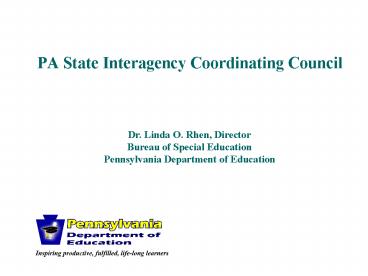PA State Interagency Coordinating Council - PowerPoint PPT Presentation
1 / 20
Title:
PA State Interagency Coordinating Council
Description:
Governor Rendell's strong emphasis on early childhood education ... 20. Edward G. Rendell Gerald L. Zahorchak, D.Ed. Governor Secretary ... – PowerPoint PPT presentation
Number of Views:62
Avg rating:3.0/5.0
Title: PA State Interagency Coordinating Council
1
PA State Interagency Coordinating Council
Dr. Linda O. Rhen, DirectorBureau of Special
EducationPennsylvania Department of Education
2
Governor Rendells strong emphasis on early
childhood education
- Accountability Block Grants for Pre-Kindergarten
and Full Day Kindergarten - Expansion of Keystone STARS, Success By Six
- Enhancement of Head Start Supplemental Programs
- Development of Early Learning Standards
3
Inclusive Opportunities for Preschool Children
with Disabilities in PA
- BSE has initiated
- Major changes to MAWA Special Education Plans
that emphasize increase in inclusive
opportunities, strategies for community
engagement and local partnerships. - Addition of inclusion targets and strategies to
increase inclusion in MAWA special education
plans, for the first time. - Increased accuracy of data collection, analysis
and reporting.
4
Environments for Preschool Children 04-05
5
Environments for Preschool Children 05-06
6
Environments that are considered inclusive
- Early Childhood EC
- Early Childhood Head Start EC-HS
- Services provided in the Home Home
- Part Time EC Part Time ECSE PT-PT
- Reverse Mainstream Rev Main
7
of Preschool Environments 05-06
8
of Preschool Children in Inclusive Environments
9
Environments for Preschool Children 03-06
EC Early Childhood EC-HS Early Childhood Head
Start ECSE Early Childhood Special
Education Home Services provided in the Home
PT-PT Part Time EC Part Time ECSE Resid Resident
ial Facility IT Itinerant Services Outside the
Home Sep Sch Separate School Rev Main Reverse
Mainstream Resid APS Residential Facility
APS Sep Sch APS Separate School APS
10
Preschool Children in Special Education
Classrooms 03-06
11
Current (05-06) and Target (06-07) of
Inclusion
12
MAWA Targets for Increasing Inclusive
Opportunities
- 05-06 school year
- Range of Children in Inclusive Environments 18
- 98. - 9 MAWAs have 66 or more in Inclusive
environments. - 7 MAWAs have 35 or less in Inclusive
environments. - 06-07 school year
- All MAWAs are targeting to have at least 35 or
more children in inclusive environments. - 9 MAWAs have targeted to have 71 or more
children in Inclusive environments. - All MAWA Plans include an increase in inclusive
opportunities.
13
MAWA Strategies to Increase Inclusive
Opportunities
- Partner with Head Start, Keystone STARS, Success
by Six and private Early Childhood Education and
day care providers to increase collaboration and
provide additional placement options. - Continue to work with community engagement groups
to increase their awareness. - Train data entry staff to improve the accuracy
of data collected. - Increase the number of typical peers enrolled in
ECSE to meet the 50 standard to be considered
reverse inclusion.
14
MAWA Strategies - Continued
- Review IEPs of students currently receiving
services to determine if those services can be
delivered in a less restrictive environment. - Increase the number of PT/PT environments, and
support them by providing consultations,
collaborations to early childhood environments. - Actively partner with existing school district's
pre-K programs and develop partnerships with
newly initiated school district pre-K programs.
15
MAWA Strategies - Continued
- Increase joint personnel training with EC
community in areas of classroom management to
decrease the number of children who have to be
removed from the class due to behavior problems. - Provide more itinerant services in typical
preschools. - Train classroom teachers to accurately code
children attending both ECSE and community
placement.
16
MAWA Strategies - Continued
- Utilize the Interagency Coordinating Council
committees to change perceptions in both Part C
and Part B to emphasize inclusive programming for
children in transition. - Explore additional grants to provide financial
assistance to families who cannot afford to send
their children to quality preschool programs.
17
National Information PreSchool Inclusion
- SPP Indicator 6 Percent of preschool children
with IEPs who received special education and
related services in settings with typically
developing peers. - States have reported a range from 15 -100 of
children in inclusive settings in their State
Performance Plans. (Territories like American
Samoa, Guam and Virgin Islands are the ones
reporting 100 inclusion). - National Median is 43, PA is at 49.
18
National Information PreSchool Inclusion
- States have defined inclusive settings
differently some have included Itinerant
services while others have excluded Reverse
Mainstreaming. - If PA included IT as an inclusive environment,
PAs 05-06 data would be at 67. - States have self selected inclusion targets for
2010 at various levels. - Targets are based on improvement from 04-05
baseline data.
19
National Information PreSchool Inclusion
- Strategies to increase inclusion
- Training and Technical Assistance
- Improve Monitoring
- Disseminate Best Practices
- Improve Data Collection
- Collaborate with other Early Education
Initiatives - Increase Public Awareness
- Clarify Policies and Procedures
- Advocate for Additional Funds
- Increase/Improve Local Infrastructure
20
Edward G. Rendell Gerald L. Zahorchak,
D.Ed. Governor Secretary































